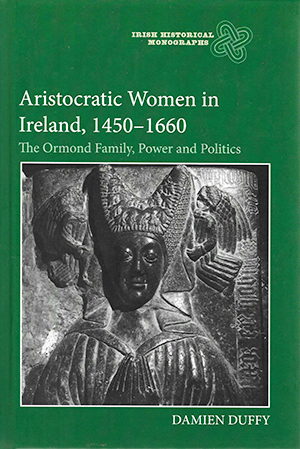ARISTOCRATIC WOMEN IN IRELAND 1450–1660: THE ORMOND FAMILY, POWER AND POLITICS
Published in Book Reviews, Book Reviews, Issue 1 (January/February 2022), Reviews, Volume 30 DAMIEN DUFFY
DAMIEN DUFFY
Boydell Press
£75
ISBN 9781783275939
Reviewed by Gillian Kenny
Gillian Kenny is a research fellow at the Centre for Gender and Women’s Studies, Trinity College, Dublin.
This book is dedicated to two women, the grandmothers of the author. In their honour, Damien Duffy has constructed a fascinating and engaging work focused on the aristocratic women of the Ormond lordship in Ireland. Its success is partly due to the author’s style—he writes in a punchy and very readable way—but he is also blessed with tremendous source material.
The Ormond women whom we meet in this book are a fascinating mix of consummate politicians and seasoned street fighters. During some very dangerous times, they strategised, fought and planned to protect their families. Powerful women in both Ireland and England, they were also flawed and very relatable. What reader could fail to empathise with Joan Fitzgerald, sixteenth-century dowager countess of Ormond, who bitterly complained of how her power was being limited by remarriage to an Englishman? So frustrated was she at this scenario that she randomly fired artichokes at Brian Jones, the constable of Carlow, to whom she was complaining. After that, she jumped on her horse, declaring, ‘O Mr Jones, I know not what to say or do, except I should fight for it’, and then rode off.
It is a scene worthy of a movie and a reminder that so many of the more remarkable stories of the women of Ireland are still there for the telling. As the author himself points out, ‘the body of scholarship on women of … Ireland … is comparatively small’ in comparison to work done, for example, on contemporary France or England. This is due, in part, to fewer surviving sources, but much information can still be gleaned from those we have, which give illuminating insights into women’s roles as aristocratic wives, daughters and widows.
Indeed, the contributions that these women made are of particular interest, as they lived through sometimes cataclysmic periods in Ireland’s history. From the 1460s onwards—when the Ormond women were dealing with the fallout of their male relatives’ involvement in the Wars of the Roses, and right through the Reformation, plantations and upheavals of the sixteenth century and on into the new realities of a post-Gaelic, New English-led seventeenth-century Ireland—Duffy expertly guides the reader through these events and describes the political, social and economic upheavals wonderfully well by focusing on the women and their stories. The difficulties faced by many Old English families (such as the Ormonds) meant that their women, some of whom are beautifully evoked, had to become ‘particularly pugnacious’ during these years.
That they did this as wives, mothers and widows added to their prestige, according to Duffy. He makes the case that their status afforded them opportunities to wield power which would have been denied to them as single women. Marriage, however, was not a course that was always easy. Duffy relates the story of Catherine Magennis, fourth wife of Hugh O’Neill, Earl of Tyrone, as a counterpoint to the Ormond women and their agency. Catherine stated that if she had the cash to buy 100 cows she would do just that and leave her husband. What is not made very clear are the disparities between the Gaelic experiences of life as a married woman and the Old English ones of the Ormond women during this period. Even though at many points the cultures overlapped, women’s life experiences could differ significantly on the island. Even though the Ormond women are expertly contextualised in terms of their activities in English and European terms, less reference is made to the differing experiences of Gaelic contemporaries. While this will not faze the reader who is familiar with the socio-cultural complexities of early modern Ireland, it precludes the less well-versed reader from developing a sense of the cultural spectrum within which these women often navigated their family’s fortunes. To include this in detail, however, may well have led to a much longer book than the well-proportioned one just published.
In general, for women to exercise agency effectively during especially difficult times and across all cultural barriers there had to be a confluence of opportunity, ambition and political conditions which allowed female power to be exerted. This occurred for the Ormond women during the fifteenth to seventeenth centuries. They acted as patrons, politicians, suitors and agents in order to progress the Ormond agenda. Eleanor Butler, for example, acted as her husband Ormond’s representative many times over their eighteen-year marriage and was a skilled and well-connected political operator. Women such as she played crucial roles in the survival and perpetuation of the Ormond dynasty.
In some ways, Irish scholarship on women’s history may still be playing catch-up, but with this new work on aristocratic women in Ireland Damien Duffy has accomplished a leap forward for the topic. He decisively meets the task set for himself in his Introduction, where he claims that ‘the challenge facing historians is to bring them [women] in from the wings and onto the stage in the historical narrative’. In this work the women of the Ormond family are definitively set centre stage. Duffy has produced a wonderful and highly engaging investigation into the power and influence wielded by aristocratic women in early modern Ireland. I have no doubt that Ellen and Bridget would be both pleased and proud to have such a masterful new book on women in Irish history dedicated to them by their grandson.
















